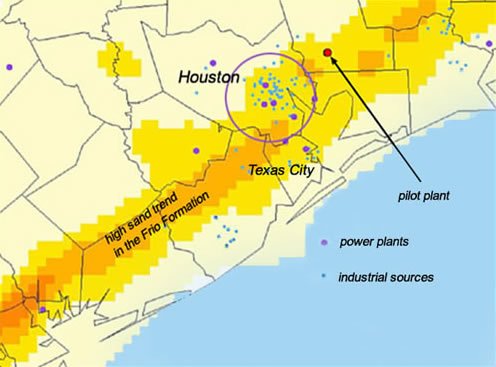Carbon Capture and Sequestration in Southeast Texas
/Southeast Texas is an ideal location for carbon capture and sequestration due to its being home to several deep saline formations which could serve as effective storage sites for carbon dioxide (CO2) captured from industrial processes and power plants in the area.
Saline formations are geological structures that contain briny water, typically at depths of thousands of feet below the surface. These saline formations are often composed of permeable sandstone or limestone layers, separated by impermeable shale layers. This layering creates a natural trap for CO2, preventing it from migrating upward and escaping into the atmosphere.
In Southeast Texas, the Gulf Coast Basin contains several large and geologically suitable saline formations, including the Frio Formation, the Wilcox Formation, and the Gulf Coast Aquifer. These formations have the potential to store billions of metric tons of CO2, making them critical to achieving carbon neutrality goals.
And not just goals for Texas, but for the entire planet.
The Frio Formation, in particular, has been extensively studied as a potential storage site for CO2. It has size, depth and permeability. Located beneath a large portion of the Texas Gulf Coast, the Frio Formation is estimated to have a storage capacity of over 20 billion metric tons of CO2.
One very pro-Texas geologist and researcher has put that number much, much higher.
But to put that number into context, 20 billion metric tons of CO2 equals about two-thirds of the global energy-related carbon dioxide emissions in a single year.
Now, of course, not all of the potential storage capacity of the Frio Formation will be used – that’s just how the world works. But, we can conclude that it is no exaggeration that the Frio Formation – by itself - if aggressively utilized would have a material impact on the world’s carbon emissions.
And of course Southeast Texas is advantaged as a location for CCS because of the major industrial sources of CO2 right there in the region, such as oil refineries, chemical plants and power plants, including:
Refineries:
ExxonMobil Refinery, Beaumont
Valero Refinery, Port Arthur
Total Port Arthur Refinery, Port Arthur
Motiva Refinery, Port Arthur
Chevron Phillips Chemical Company, Port Arthur
Chemical Plants:
BASF Corporation, Freeport
Dow Chemical Company, Freeport
DuPont Chemical Company, Orange
Huntsman Corporation, Port Neches
Eastman Chemical Company, Beaumont
Power Plants:
Sabine Power Plant, Bridge City
Mont Belvieu Power Plant, Mont Belvieu
San Jacinto Power Plant, Houston
Cedar Bayou Power Plant, Baytown
Limestone Power Plant, Jewett
All of which is to say, the Energy Capital of the World – Texas – can and will play a significant role in carbon reduction, and therefore the energy transition.
Years ago, Sam Houston noted that “no country upon the globe can compare” to Texas’ “natural advantages.”
Certainly, it is providential and speaks well of Texas’ natural advantages when we consider the fortuitous circumstance of many of the world’s most important carbon emitters are located only a stone’s throw from a natural geological location for carbon capture and sequestration.
You can hear Sam Houston saying, “I told you so.”




